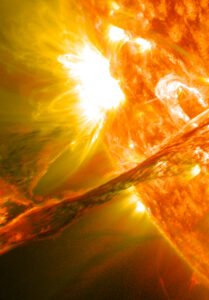Before the 19th century, people believed there was not much left to find and prove in Physics. Newtonian Physics answered everyday questions faced by a civilisation bound to the surface of the planet.
There were, however, a couple questions that scientists were not able to answer – and one of these was about the nature of light. In Western science, circulating were two competing theories regarding what light actually is: a unique stream of particles or a unique type of wave.
A significant portion of nineteenth-century research focused on defining the medium in which light was supposed to travel. During this time, the most accepted description for this medium was called ether, or aether and was described as being present everywhere, invisible, massless and capable of interacting only with light.
Two American scientists, Albert Michelson and Edward Morley, tried to prove the concept of aether with an experiment.
They used two mirrors, one light source, one semi-silvered mirror reflecting only half the light while the other half was transferred, and a detector allowing them to investigate whether there was a time difference between how the two streams of light travelled.
A ray of light was projected onto the semi-silvered mirror, positioned at a 45-degree angle to the light ray. Michelson and Morley believed that there was a ‘wind of aether’ which would cause the light to gain or lose some speed, and therefore the two streams of light would arrive at the detector at different times.
The experiment proved otherwise: light was observed on the detector every time at the same moment, without any difference. The scientists attempted to prove their ‘wind of aether’ theory a couple of times, yet the final statement remained the same. Michelson and Morley eventually concluded their work by saying they failed because there was no change in phase.
Over time, their experiment proved to be maybe one of the most famous failed attempts in the history of Physics. However, it certainly was not an unfruitful one: caused a lot of discussion and was a turning point for scientific discoveries which soon followed. Michelson and Morley’s failure resulted in considerable brainpower being devoted to attempting to explain the nature of light.




